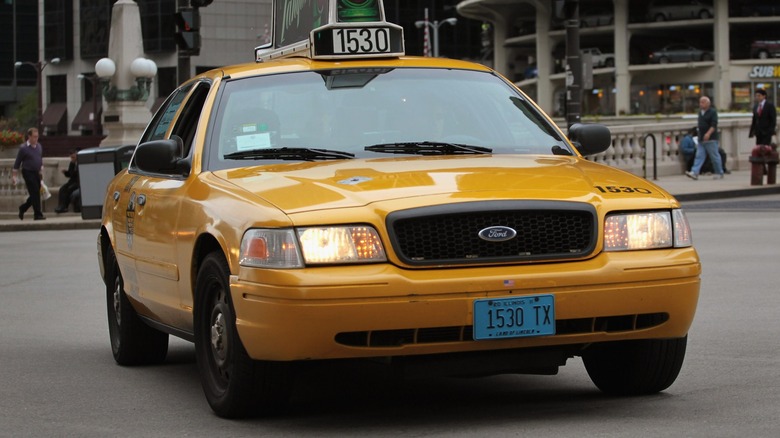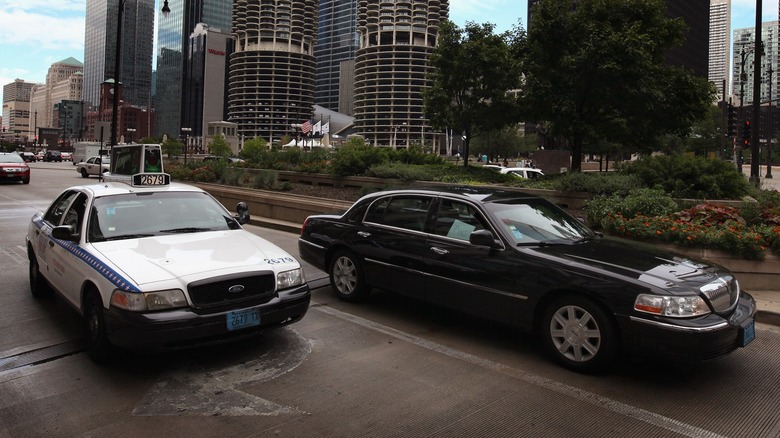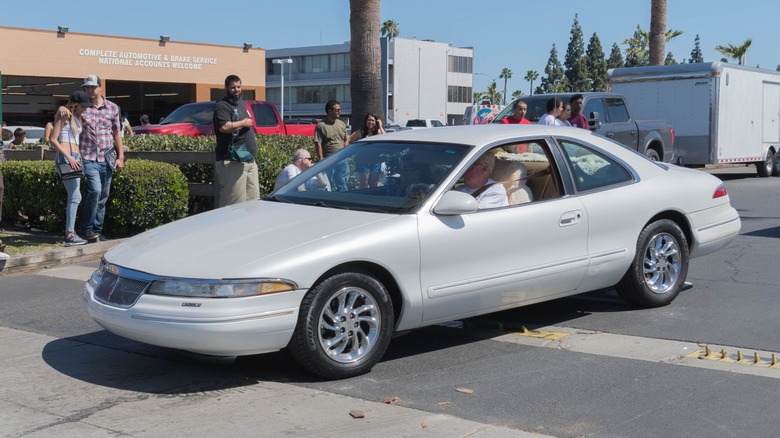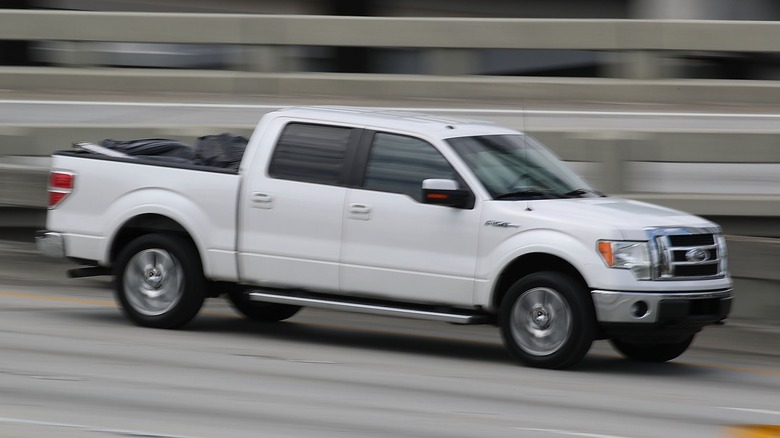
Scott Olson/Getty & undefined
Ford’s first regular production overhead-cam V8 engine proved to be a rousing success for the company. As the times were changing heading into ’90s while technology evolved at a fever pitch, Ford had to do something with its 30-year-old V8 engine design. Needing a new engine with updated technology that would continue to deliver on the promises of power, affordability, and durability Ford engines were known for, a robust but simple overhead design was chosen.
Dubbed «Modular» for the manufacturing technique that made it cheap and easy to make alterations to the block while maintaining the same basic structure, the new 4.6-liter V8 debuted in the 1991 Lincoln Town Car. Ford had entered a new era in terms of engine development as it headed towards the new millennium. Now with several decades having passed since the introduction of this pivotal engine technology, it’s time to look back on the many models that received the Modular engine. This is every model powered by the Ford 4.6 Modular V8.
1991-2011 Lincoln Town Car

Chris Hondros/Getty
Built upon the versatile and robust For Panther Platform, the Lincoln Town Car received a major power upgrade in 1991 when its pushrod-driven Windsor 5.0 V8 was replaced with the new Modular 4.6. This generation was pivotal for the large Town Car as it kept its boxy shape while softening the abundance of sharp corners and shedding the oversaturated rectangular design elements.
Under the hood, the new smaller V8 kept Ford’s luxury car buyers satisfied with ample power. Despite being a smaller engine, horsepower increased by 40 to 190 with the new engine. While the increased power and torque came on a higher engine speeds, it is likely that Lincoln buyers noticed little about the upgrade so long as their cars remained smooth, comfortable, and powerful enough. While the introduction of the Modular engine in the Town Car was met with little fanfare by the automotive press, future Fords would find plenty of ink spilled in both criticism and praise of the soon-to-be ubiquitous power plant.
1992-2011 Crown Victoria

Scott Olson/Getty
For the 1992 model year, Ford replaced its long-running LTD family sedan with a new model adopting the name from the highest trim level of the LTD, Crown Victoria. Continuing to be built upon the Panther platform, the new Crown Victoria updated and modernized the boxy LTD into a smooth and svelte new package featuring modular headlights streamlined into the contour with a plush interior and the new 4.6-liter V8 under the hood.
Millions of Crown Vics were sold before being discontinued in 2011. Perhaps more than any other model, these cars proved the longevity of the 4.6-liter V8 as it was found under the hoods of scores of taxicabs and police cars from coast to coast in the North American market. Much too large for foreign markets, the Crown Vic was a homegrown favorite. As recently as November 2023, The New York Times reported on a NYC taxi with 550,000 miles on it, one of the last remaining Crown Vics on the city’s streets. Ford discontinued the Crown Victoria in 2011, ending the reign of the last full-size Ford sedan.
1992-2011 Mercury Grand Marquis
While the Crown Victoria reigned supreme as the fleet vehicle of choice for taxi companies and police departments everywhere, its cousin, the upscale Grand Marquis, became the vehicle of choice for nice uncles and kindly grandmas in the suburbs.
With the same foundation as its Ford sibling and powered by the same engine, the Grand Marquis is nearly indistinguishable be it not for the badging on the rear deck lid. Inside, upscale appointments such as leather upholstery and additions like compasses and exterior thermometers may have been more often seen on the Mercury. On the whole, these cars are twins with little to tell them apart. The final models of Grand Marquis rolled off the assembly line in 2011, which marked the end of the model and the brand as Ford retired Mercury as part of a restructuring and streamlining plan.
[Image by IFCAR via Wikimedia Commons | Cropped and scaled | CC BY-SA 3.0]
1993-1998 Lincoln Mark VIII

betto rodrigues/Shutterstock
After debuting the 4.6-liter V8 on the Lincoln Town Car, Ford designers and engineers set their sights on updating the stylish and sporty Lincoln luxury coupe, the Mark VII. Dubbed the MK VIII for the 1993 redesign, it arrived with much more curvature on its body panels in line with contemporary styling along with the multi-port fuel injected OHC Modular V8.
The Mark VIII symbolized the ideal combination of American luxury and performance. As comfortable as anything from Europe, the Lincoln’s engine technology was just as powerful without being needlessly complicated and fussy. Just because buyers are willing to fork out extra cash for modern luxury, the Mark VIII made it clear that added complexity was unnecessary. However, while its beating heart came in with cams in the same place as the lowly Crown Victoria, there were four of them instead of the standard two, providing Mustang Cobra level performance in a package with a bit more panache. Boosting this was a concept Mark VII made with trick disappearing doors. Obviously, this never made it to production.
1994-1997 Ford Thunderbird
With an introduction in 1955, Ford made its mark on the market for sporty two-seaters with a car that would become the quintessentially symbolic American cruiser icon, the Ford Thunderbird. However, the formula that made it initially successful changed in the 1960s when it grew in size and passenger capacity. The Thunderbird essentially created the «personal luxury car» segment and kept it going strong through the rest of the century, but with a coda in the form of a retro revival styled after the original produced in 2001 after a brief hiatus.
For the end of the run of 20th century Thunderbirds, Ford adopted the 4.6-liter V8 to replace the 5.0-liter Windsor that had been powering Thunderbirds for years. This generation of Thunderbird kept the same basic design of the previous model with styling changes updating its looks in line with others in the Ford lineup. The 4.6-liter V8 was an upgrade from the previous V8 but did not stand out at the top of the pack. For the ultimate in Thunderbird performance, buyers opted for the Super Coupe with a supercharged 3.8-liter V6.
[Image by IFCAR via Wikimedia Commons | Cropped and scaled | CC BY-SA 3.0]
1994-1997 Mercury Cougar
Like many other Ford models, the Thunderbird received a Mercury sibling in the form of the Cougar. Although the Cougar started life as a high-performing mate to the Ford Mustang, its direction soon changed as it went towards the personal luxury market and it moved to share its platform with the Thunderbird. Both the Thunderbird and Cougar were discontinued in 1997, although a new Mazda-based model reappeared in 1999 as a completely different kind of car altogether.
Like the Thunderbird of the same period, one of the engine options for the Cougar was the 4.6-liter Modular V8. The base model for these models was the 3.8-liter V6, although the range-topping trim level was the XR7 with a 4.6 — no supercharged cats were produced. However, the Mercury continued to be a well-appointed and moderately luxurious option to the Thunderbird with a healthy list of options and upgrades available throughout its run.
[Image by IFCAR via Wikimedia Commons | Cropped and scaled | CC BY-SA 3.0]
1995-2002 Lincoln Continental
While 2020 was the last year of production in North America for the Lincoln Continental, the name has been a part of the brand for a very long time. It started as the Zephyr Continental in 1939 as the sportier coupe, undergoing substantial changes over the years. By the mid-90s, it was a mid-sized companion to the full-size Town Car. In 1995, a new Continental arrived sporting more curves than its predecessor as well as a new 4.6-liter V8 to replace the only available option from before, a transverse-mounted V6 shared with the Taurus.
By 1999, horsepower output had increased to 275, making this Lincoln a true contender to similar imported luxury sports sedans. The DOHC 32-valve 4.6-liter V8 gave it ample efficient power with smooth running. The exterior had departed from the staid boxy designs of the ’80s and looked poised to set Lincoln apart from the competition. However, increased competition from Japanese newcomers put on the heat and the Continental was phased out in 2002. That was the last time Lincoln produced a Continental until the short-lived 2016 revival.
[Image by IFCAR via Wikimedia Commons | Cropped and scaled | CC BY-SA 3.0]
1996-2014 Ford Mustang
For many years, the Ford Mustang was inextricably linked with the 302 V8, renamed 5.0 with the Fox body introduction in 1979. However, the Windsor engine architecture eventually became aged and needed a replacement. While the Mustang held out longer than others, it eventually received the SOHC 4.6 in 1996. Small block Mustangs had once delivered jaw-dropping power in the days before emissions regulation, and that power began its return in the early ’90s. Nonetheless, the 4.6 was not prepared to disappoint, no matter what people thought of it.
When the Modular Mustang was brand new, articles such as those from Motor Trend hinted at trepidation of having a Mustang no longer dominated by the 5.0. After all, the Mustang had been steeped in tradition after decades of production, so it can be difficult to make converts to new technology out of stalwart fans. However, impressions of the new block after driving generally came back positive, noting the improvements realized from moving the camshafts up to the top of the heads, allowing for less weight and higher revs. Since a Cobra version also debuted with double the camshafts at the same time, converts were quickly found among the faithful. Fast forward to 2015 when the Coyote 5.0 finally replaced the Modular 4.6, and Motor Trend’s anticipation replaced the trepidation of a decade before.
[Image by Daderot via Wikimedia Commons | Cropped and scaled | CC BY-SA 3.0]
1996-2014 Ford E-series
Alongside the Mustang in 1996, the venerable Ford E-Series van replaced its old pushrod Windsor with the new Modular 4.6. While large vans are known to have a need for large engines with lots of torque built at low revs, the new engine seemed to prove itself and have no problem hauling big loads as Ford kept it in the vans until 2014.
The E-Series traces its roots back to the original Econoline vans of the early ’60s when they were built as cab forward designs with the driver sitting over the front wheels. While these novel and interesting vans served their owners reasonably well, a more traditional design took over in the ’70s, becoming the iconic full-size vans that roamed the streets for decades. The last generation of vans built for passengers or cargo lasted until 2014 and were powered by the 4.6 — The European-designed Transit replaced them. Changing markets and company priorities led Ford to phasing these vans out for all versions except as chassis cab models meant for box truck or RV duty. These also eliminated the 4.6 in favor of the Modular V10 and a new 7.3-liter V8 in 2019.
[Image by IFCAR via Wikimedia Commons | Cropped and scaled | CC BY-SA 3.0]
1997-2004 Ford Expedition
Ford has long been known for building large trucks. Furthermore, it has also long been associated with its robust and expendable pickups. As the market of the late ’90s began shifting for some reason toward passenger vehicles that combined the handy space and features that a station wagon provides with the poor fuel mileage and less capable handling of a pickup, Ford delivered the Expedition, an unusually tall station wagon called an SUV.
Expedition production began in 1997, offering families mostly in North American ample space for their kids, kids’ friends, and half a soccer team’s worth of gear. Based on the F-150 pickup, it shared a great many parts, including the 4.6 or 5.4-liter V8 engines. These were both part of the Modular family and could be mated to either two or four-wheel-drive. A new generation Expedition debuted in 2003, continuing with the same engine choices and adding the 3-valve Triton engine in 2005. With the new model in 2007, the 4.6-liter option was dropped, but the Expedition remains in production today.
[Image by Yamenah via Wikimedia Commons | Cropped and scaled | CC BY-SA 3.0]
1997-2010 Ford F-150

Joe Raedle/Getty
Ford’s mainstay best-selling pickup was the last to receive the 4.6-liter engine. As one of the longest and best-selling vehicles in the country, Ford was reluctant to upset its loyal buyers with too many changes to one of its legacy makes, but eventually relented and updated its F-150 pickup in 1997.
The F-150 could be ordered with either the 4.6 or 5.4-liter V8 from 1997 through 2010. These proved to be reliable and robust engines that had already been proven in service with Crown Victorias for several years, and sales of the trucks continued apace regardless of which engine they came with. The 5.4, called the Triton, eventually received an upgraded head with three valves-per-cylinder and variable valve timing in 2004, but the 4.6 would not receive the same treatment until 2009, just in time for it to be phased out forever — though the F-150 continues to be a best-seller.
2002-2010 Ford Explorer
The Ford Explorer is one of the most important vehicles ever developed by Ford. Its introduction in 1991 helped to make the SUV a widespread phenomenon and became a huge selling success for Ford. Initially built on the platform of the Ford Ranger, the Explorer later came on a modified and widened version of the Ranger frame and became a fully separate model in 2002. This is also the first year it received a 4.6 V8.
From 2002 to 2010, Explorers could be optioned with either the beefy 4.0-liter V6 or the 4.6-liter V8 for those wanting more torque, particularly for pulling trailers. Ford also offered a Mercury Mountaineer featuring only marginal interior upgrades before being phased out in 2010, and the Explorer Sport-Trac, which was a sort of SUV/pickup combination that also sold from 2001 to 2010. For those wanting the ultimate Explorer with top-of-the-line luxury, the Lincoln Aviator also received the 4.6 V8 through the same period.
[Image by IFCAR via Wikimedia Commons | Cropped and scaled | CC BY-SA 3.0]
2003-2004 Mercury Marauder
Perhaps the shortest lived but most underappreciated Ford top come with a 4.6-liter Modular V8 is the Mercury Marauder. Built upon the Grand Marquis, the Marauder was Ford’s high-performance version of its full-size car, giving power and performance reminiscent of the muscle cars of the past. The engine was indeed a 4.6-liter, but it had dual-cams, 32 valves, and output more than 300 horsepower.
The Marauder was a slightly menacing sedan that hid its true potential under the guise of a typical dawdling family sedan. However, with the accelerator mashed to the floor, this sleeper woke up and went to town in a cloud of tire smoke. In addition to the upgraded engine, Marauders also benefited from having Police Interceptor brakes and upgraded suspension as well as custom embroidered bucket seats with a center console. Sadly, sales did not match this Mercury’s potential and it was retired after only two model years and is rising in value today.
[Image by IFCAR via Wikimedia Commons | Cropped and scaled | CC BY-SA 3.0]